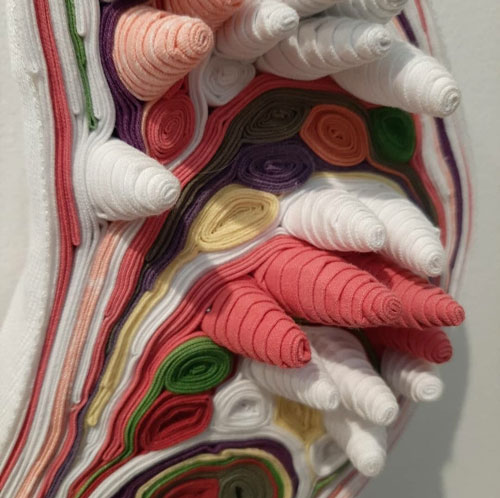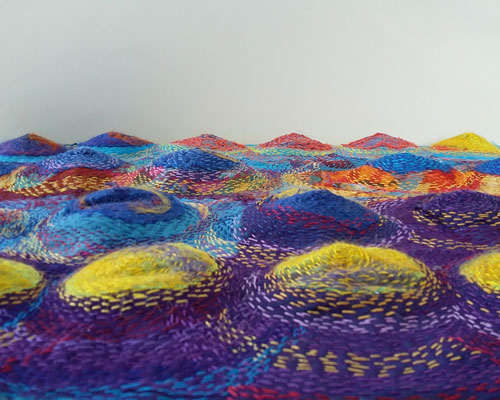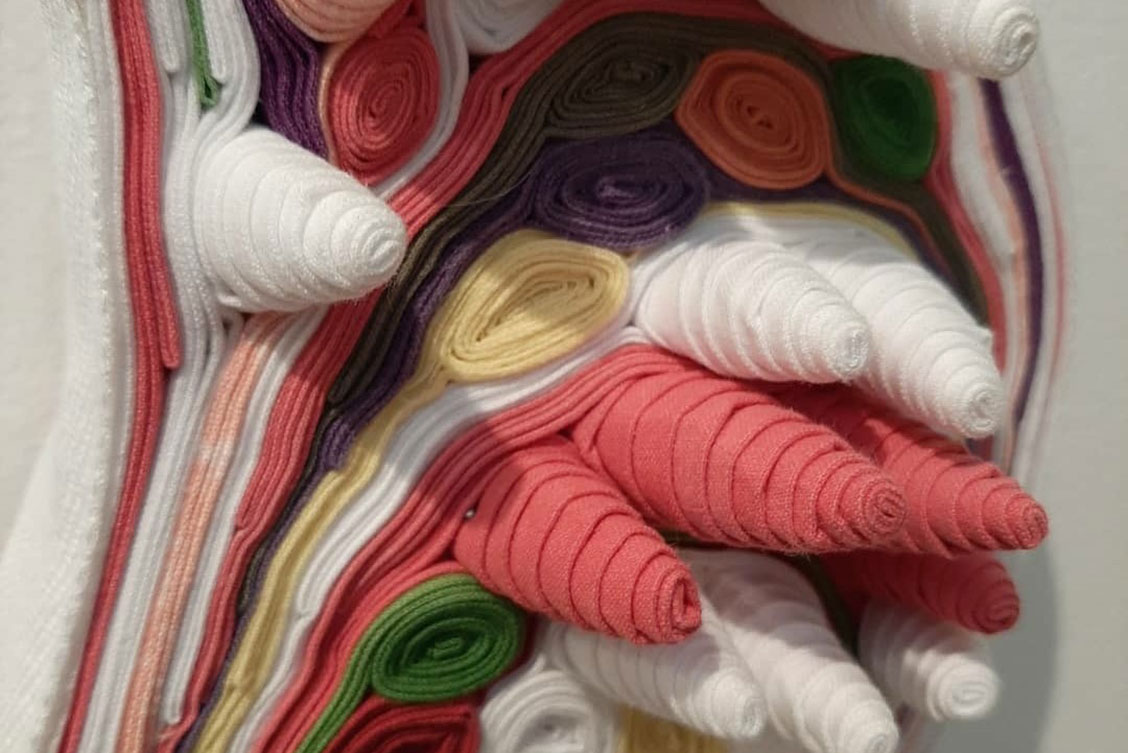Tell us a little bit about yourself
I have been living in Co. Meath for more than 40 years, but I grew up in the North of Norway. Craft and then later art have been sustaining hobbies in my life.
In 2008, after 30 years as a social worker, I retired and attended a PLC (Post Leaving Certificate) college completing FETAC Level 5 and 6 courses in art. I was then accepted into NCAD (National College of Art and Design) where I graduated with a Diploma in Art and Design in 2011.
What area of the arts do you work in?
I am a maker. The process of making has always excited me.
I have been a practising visual artist since I graduated and have a purpose-built studio in my back garden. My art practice has evolved through experimentation with materials, media, different expressions, and collaboration with other artists.
How long have you been working in this area of the arts?
Although I have described myself as a process based, multidisciplinary artist, which means I combine different types of artforms, creating both 2-dimensional and 3-dimensional art works using a variety of media; over the past 4 or 5 years I have found myself drawn more and more towards fibre and textile art.
I have created a number of soft sculptures, 3-dimensional forms made from fibre and cloth. I often use traditional craft techniques like felting, knitting or crochet in the process. I have also created single artworks and installations of multiple wall mounted textile pieces.
What materials do you use to make your artwork?
I am currently using fibre and textiles in my art practice, preferably recycled or salvaged materials. I try to tread lightly on this earth by using textile waste and cloth, old clothes and I upcycle where I can. However, I still use drawing, painting, mono printing, and cyanotype printing in a process. (Cyanotype printing is the first form of photography using the sunlight and light-sensitive paper).

'Thews and Sinews', 13-piece wall installation
I use wool and cotton fibres which I unravel or pull apart, cut, or tear from recycled cloth and synthetic materials which can be manipulated or changed with heat. Once I have prepared the fibre, I begin to put it together on a canvas to create a textured 2D artwork. I also use other materials like wax, wood, wire mesh or plaster with soft fibre materials to create 3D forms.
I layer and manipulate the materials until they are unrecognisable from their original purpose, totally changing their value to express my idea or theme and putting them into a contemporary artistic context.
What or who inspires you?
My inspirations are a combination of influences and interests.
A core theme of my art practice from the very beginning has been research into my ancestors, the Samé people of the northern hemisphere; their cultural, political and economic life as well as the harsh climatic conditions they live in. Stories from my family history and cultural traditions as well as the colours and textures of the environment in Norway greatly inspire my work.
Alongside these core interests, I love collaborating with other artists on common themes and I am a member of a number of art groups both locally and in Dublin. Working collaboratively is an enriching experience which can have far reaching benefits. Running an art practice can be a very solitary and isolating existence, working on your own for long periods of time so and it is important to seek out like minded artists to work with and be inspired by.
While still in college I was inspired by American artists like Eva Hesse and Lynda Benglis who introduced me to the 3-dimensional forms using unusual materials, particularly wax. Later, when fabrics and textile became an important material for me, the work of Polish artist Magdalena Abakanowicz, French artist Simone Pheulpin and American artist Sheila Hicks had a profound effect on me in terms of experimental textile sculpture art.

‘Rhapsody in Blue’, detail by Mette Roche
Inspired by the Slow Stitch movement, that encourages you to slow down and be creative through sewing, I have discovered the simple repetitive hand stitch, which can be combined with other recycled and layered textiles to create character, texture, and colour. It is also a meditative and therapeutic process which I believe has positive benefits for both the maker and viewer of the work. The English artist Richard McVetis was an important source of inspiration in this area.
How do you start a new piece of work or explore a new theme?
Picking a theme
My research into the lives of my ancestors has given me many ideas and themes, their turbulent and difficult history, the symbolic meaning of colours in their cultural traditions, nature’s extreme expressions and personal family memories.
Research
When I have selected a theme for a project or collaboration, I start by looking through my expansive collection of materials gathered over many years. I mainly work intuitively with each artwork, not having a definite end result in mind. I let the materials direct the process as well as my own creative instinct and aesthetic sense. The qualities of the medium inspire the form and the expression I create. Researching other artists who work with similar materials can be inspirational and this is where my own experimentation and exploration starts. The process is what drives me and gives me energy, not the thought of a finished artwork.
Documentation
Throughout the process I keep writing down ideas about what I want to express, and this again may influence the direction of a project or be an inspiration for a new project.
Taking photographs of the artwork throughout the process is an important tool and creates a record for future use, maybe in another project. Often one project may inspire another and so on.
Exploration
Exploring other artists’ work, either in art books or online, or visiting exhibitions are invaluable and can give new energy and impetus to a project. Textile art has become a more important part of the contemporary art scene in recent years, if not yet of equal value to traditional art forms such as painting and sculpture, this means that it is easier to access written material and online sources on the subject.
Exploration and experimentation of the materials is key. Pushing beyond what you think is the limit is exciting as well as combining unusual materials to create a form or add texture and colour.
Collaborating with other artists on a common theme is extremely rewarding. It gives you feedback on your own artwork and other artists stories and expressions can be inspirational. In a group exhibition, close collaboration and influences can be evident in individual artists finished artwork.
The eternal question is: when is a work of art finished?
I would say, when I feel there is an aesthetic balance and I get a certain buzz from looking at it. Except the process is often ongoing. I may start a drawing of a sculpture I have just made, to give it a different expression; to create an installation of many drawings; use a photo of the art work in a cyanotype printing process or use the surface texture in a mono printing process. It is like taking the artwork on a new journey.
Do you have any advice for our young creators and artists?
To any aspiring young artist out there, do not let any preconceived limitations stop you. By this I mean, follow your instincts and not what you think will work, keep experimenting. Always be open to change. I respond to themes and concepts through collaborations with art groups and to materials I find or are presented to me. Materials do not have to cost a lot of money. Use what you find around you, everyday materials which can be recycled or upcycled are sustainable and experimentation and exploration is the key. The possibilities are endless.
Today the opportunities for pursuing a formal education in art is so much better than when I was young. After retiring I took advantage of these opportunities to the full and I have not looked back. If you have a strong interest in art, research the educational opportunities near you and go for it!
